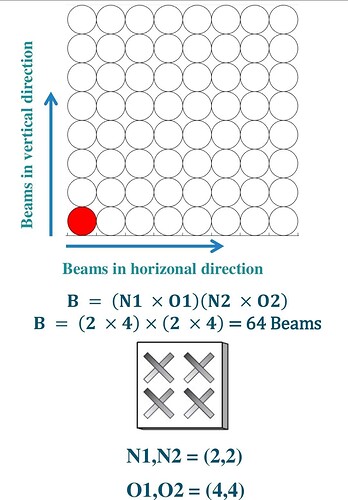-
Grid of Beams (GoB) precoding is a codebook-based precoding technique used in 5G systems.
-
GoB precoding works by dividing the space into a grid of beams.
-
The gNB selects a subset of beams to transmit data to the user equipment (UE) based on the likelihood of reception by the UE.
-
The number of beams in the grid is determined by the number of antennas in the gNB antenna array.
-
In 5G, antenna arrays are defined by: N1: the number of columns and N2: the number of rows. for example N1=2 and N2=2 is shown in the figure.
-
The number of total beams that can be formed in the grid is equal to: (N1×O1)×(N2×O2).
-
The oversampling factors (O1 and O2) helps to maximizes precoding gain by spanning for more directions that can precisely locate the UE.
-
The beams are formed by combining signals from different subsets of the antennas in the gNB antenna array.
-
The signals are combined using a precoding matrix, which adjusts amplitude and phase of the signals.
-
The precoding matrix is designed to maximize the signal-to-noise ratio (SNR) at the UE. A higher SNR results in a better-quality signal.
-
A Discrete Fourier Transform (DFT) based GoB is a precoding technique that contains a fixed number of precoders.
-
Unlike other techniques such as MRT or ZF, which estimate beamforming weights from the channel matrix to precisely optimize the received power, GoB has a definite, predefined number of beamforming weights.
-
The beamforming weights in GoB are determined based on a Discrete Fourier Transform DFT.
-
Each beamforming weight in the DFT-based GoB corresponds to a specific direction in space.
-
The DFT-based GoB is a simple and efficient way to implement beamforming in mobile communication systems.
-
The use of a fixed number of beamforming weights in the DFT-based GoB simplifies the hardware and reduces the computational complexity of the system.
LinkedIn: ![]()
